In today’s rapidly evolving technological landscape, the term “Generative AI” is gaining fame with new tools like ChatGPT and Jasper.ai. But what exactly is Generative AI, and how does it differ from traditional AI and machine learning? In this article, we’ll break down the concept of Generative AI in simple terms, explore a real-world example, and highlight the distinctions between Generative AI and other AI techniques.
What is Generative AI in Simple Terms?
Generative AI refers to a class of artificial intelligence that focuses on enabling machines to exhibit creative and imaginative capabilities. Unlike traditional AI systems that rely on pre-defined rules and patterns, Generative AI empowers machines to generate new content that wasn’t explicitly programmed. Essentially, it involves teaching machines to learn patterns from existing data and then use that knowledge to produce something new and original.

Example of Generative AI
One compelling example of Generative AI is the creation of images by computers. Imagine a scenario where a machine is fed thousands of pictures of digital art. Generative AI algorithms programs like Midjourney can analyze these images of art, learn the common styles, colors and sizes of various digital art pieces, and then generate entirely new images of digital art that have never been created before. This ability to create content based on learned patterns is what sets Generative AI apart.
Here is an example of Generative AI image created with Midjourney.com

Difference Between AI and Generative AI
Artificial Intelligence (AI) is a broader concept that encompasses the simulation of human intelligence processes by machines. It includes tasks like problem-solving, decision-making, and language understanding. On the other hand, Generative AI is a specialized subset of AI that focuses on creativity and content generation. While traditional AI systems excel at performing specific tasks, Generative AI goes beyond these limitations to produce new, innovative outputs.
Generative AI vs Machine Learning
Generative AI and machine learning are closely related but not synonymous. Machine learning involves training algorithms to improve their performance on a specific task by learning from data. It can be both discriminative (classifying input data into predefined categories) and generative. Generative AI, however, specifically concentrates on producing content. In other words, all Generative AI is machine learning, but not all machine learning is Generative AI.
Generative AI algorithms, such as Generative Adversarial Networks (GANs) and Variational Autoencoders (VAEs), have gained prominence for their ability to create artwork, music, text, and even videos. These algorithms learn the underlying patterns of a dataset and then generate new instances that adhere to those patterns. GANs, for instance, consist of two neural networks—the generator and the discriminator—engaged in a creative competition. The generator creates content, and the discriminator evaluates it. Over time, this interplay results in the generation of increasingly authentic and novel outputs.
The Promise of Generative AI
Generative AI holds tremendous promise across various domains. In the world of art, it’s blurring the lines between human and machine creativity, producing artwork that challenges conventional definitions of authorship. In medicine, Generative AI is aiding drug discovery by generating molecular structures with desired properties. In entertainment, it’s revolutionizing special effects and content creation.

Generative AI is a fascinating and innovative branch of artificial intelligence that’s reshaping how machines interact with and contribute to the creative process. It’s not just about solving problems; it’s about pushing the boundaries of what machines can conceive. By enabling machines to generate content that’s imaginative and novel, generative AI is opening up new possibilities across industries and sparking a new era of collaboration between human creativity and machine intelligence. As the field continues to advance, we can only imagine the astonishing feats that generative AI will achieve.
